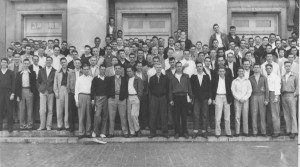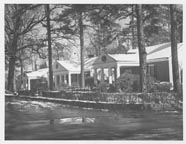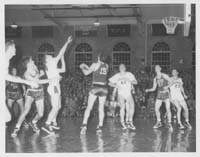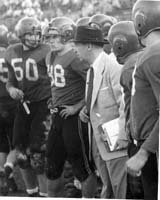In the winter of 1952, a lion cub ran through Davidson’s manicured campus. Sigma Alpha Epsilon ordered their pledges to capture the lion cub. Of the 277 freshmen men, nearly eighty percent pledged, and, of those, 80 percent were the fourteen SAE pledges searching the grounds for a lion cub. These antics were part of the “boys will be boys” philosophy of 1950s Davidson. According to Hartley Hall, ‘51, “We were always in trouble.” While the public perception of 1950s Davidson men was “a Davidson gentlemen needs no introduction,” students did also engage in pranks and hijinks while simultaneously succeeding academically and in service through institutions like the YMCA.

Demographics:
In the 1950s, Davidson’s student body ranged from 822 students in the academic year of 1952-1953 to 912 in the academic year of 1959-1960. Nearly all students hailed from the southeast, with the majority of those from North Carolina. There were a few students who came from north of the Mason-Dixon line, but the student body was mostly homogeneous in geography. Davidson was also all white men, since the college had yet to undergo coeducation and integration.
Davidson’s population was mostly politically conservative. In a 1952 poll, 359 students supported Dwight Eisenhower, the conservative candidate, and 129 supported Adlai Stevenson, the liberal candidate. Even the college faculty, stereotypically a liberal group, showed their favor for Eisenhower over Stevenson.
Housing/Amenities:
During the 1950s, two new dorms, Belk Hall and Little Hall, were built. Additionally, Cannon Hall was renovated in the 1950s. Construction began on Belk in 1953, shortly after Mr. Belk, a long-serving trustee, passed away. The building was finished in 1955.
Little was built in 1956 and opened in 1957. It replaced Rumple Hall, which had been there from 1903-1955. It was named for Mr. Little, who was on the Board of Visitors, and worked closely with Dr. Cunningham.
Cannon Hall was renovated from 1956-1957. It was originally built in 1923 and was called West Dormitory. It was named after J. Archie Cannon who passed away in 1956, resulting in the renovation and renaming of the building.
Duke Hall was built in 1939 and not renovated in the 1950s. Sentelle, built in 1922, also remained the same in the 1950s.
In terms of dining, freshmen during their first semester ate in the Ovens College Union. After first semester, most students ate at boarding houses that were affiliated with their fraternities. The actual fraternity houses were designated as meeting spaces. One boarding house, the Copeland House, was independent, and according to John Kuykendall, it also happened to have the best food.
In 1958, fraternities moved from Jackson Court to Patterson Court. There were twelve houses built and it cost $50,000. The court was named after William S. Patterson, an alum, who funded the construction. Once Patterson Court was built, dining changed on campus. The houses were larger and equipped with a kitchen. Fraternities hired house mothers who cooked for them, moving the Union even more out of the picture.
Activities:
In Quips and Cranks, the Davidson yearbook, the first activity listed was student government. In the 1950s, the Student Government’s biggest responsibility was upholding the Honor System, as well as “maintaining the Davidson tradition of gentlemanly conduct.”
The Young Men’s Christian Organization (the YMCA, or simply “the Y”) was an essential part of all Davidson men’s experiences at the college. All students were automatically enrolled in the Y when they entered Davidson. The YMCA emphasized the “social responsibility of the Christian.” According to president emeritus John Kuykendall,’59, the Y “was the all-encompassing student religious group… Most people were in and out and the Y had two dozen kind of insular activities like teaching Sunday School up at Barium Springs or doing service projects.” Because nearly all students were Christian, the Y touched a large majority of the students, providing opportunities for service as well as social events
Three to five times a week, students would gather for chapel in Chambers, the main academic building. Chapel, though religious in name, was not necessarily religious in practice. Sometimes chapel would have a speaker and other times students would run chapel. T. Hartley Hall, ‘51, described what chapel would occasionally look like: “The students, if they thought somebody was boring, they all opened the newspaper up and sat behind it. I remember one woman who was just, she’s the dumbest thing, she was horrible. She’d say something and everybody would go “Oh, great!” and stnd up and clap and just ridicule the crap out of her.” Students expected high quality speakers and rejected those who did not meet their standards.
Social Life:
Nationally, college fraternities experienced a revival in the 1950s. After World War II, fraternities were in crisis mode. From 1946 to 1948, colleges were filled with war veterans. The idea of being hazed in order to join a social group seemed absurd to young men who had experi
This public relations decision was effective because across America, numbers surged in fraternities. Alcohol became an integral part of the pledging process and fraternity culture. At elite institutions, such as Duke University and Dartmouth College, fraternities partook in reprehensible pranks and trouble-making. At Duke, fraternities living quarters became known as ‘the Animal Quad.’ Incidents at Duke, as well as other institutions, included vandalism, sexist pranks, and hazing infractions. In one such incident, Kappa Alpha at Duke burned a cat alive in a dormitory and left it in the hallway. This sadistic, violent behavior was a complete departure from what fraternity men championed during the daylight hours. Many were involved in student government, creating the bylaws of their colleges. But at night, these bylaws that they supported so staunchly when the sun was out were disregarded.

Davidson fraternities did not tend to go to the extremes that peer institutions did, but Davidson’s fraternities did engage in their own share of tomfoolery through inter-fraternity rivalries and pranks. In the same spring as the lion cub’s capture, a fraternity stole SAE’s brand new lions, replacing them with a toilet. These exploits were not all-encompassing, however. At Phi Delta Theta, T, Hartley Hall, ‘51, described a normal Saturday night, which involved no mischief: “[We’d] go to the fraternity house and sit down to play bridge. You’d play bridge all morning, all night, up until breakfast…nobody said a word. It was just silence all night long.”
The lack of women’s presence may have also contributed to Davidson’s comparatively tame atmosphere. But, Hartley Hall also talked about pranks Davidson men would play on women who would visit the college before it was coeducational: “We would have guys lined up to go into the toilet to keep it occupied. Of course, these gals were insecure and didn’t want to talk about this. The whole idea would be to keep them away from a toilet the whole time.” These acts did not make Davidson a safe, comforting environment for visiting women. But these practical jokes did not match the level of severity seen at peer institutions.
Athletics

In the 1955 Quips and Cranks, a summary of the year includes a description of the sentiment around the football team: “victory over V.M.I. at Lexington opens football season… suddenly student spirit, long latent, arises.” The football team had their first winning season in a long time and Davidson students apparently rallied around the team. John Kuykendall, ‘59, described varsity sports during the ‘50s: “There was not as bright a line between being an athlete and not being an athlete at that day and time. If you wanted to go out and try to play baseball, they had a[n extra] uniform. You could go try football. I played on Davidson’s first soccer team–it was absolutely ad hoc. I mean, there were about four guys, a couple of whom were internationals; a couple of whom were mish kids, missionary children who really knew soccer and were from Brazil and places like that. And the rest of us were just kind of goof-offs.” He added that “it was the same with all the other sports.
In terms of great varsity athletes, Mr. Kuykendall stated, “We had some very fine intercollegiate athletes, but that was almost by happenstance rather than by attempt.” The intense scouting system that eventually evolved in Division I sports had not yet taken root. Therefore, great Davidson athletes tended to be found by chance rather than by effort as this anecdote of a basketball player indicates: One of the basketball players on the team who was a classmate of mine had been brought from Juno, Alaska, by a well-intended UNC [Chapel Hill] alumnus to present him to UNC Chapel Hill as their new basketball player! He got there and they kept saying, “We don’t want him!” And so here was all the way from Alaska. This lawyer in Charlotte brought him down, so he just came to Davidson and walked around and they said, “Yeah, we’d like to have you.” It was about that formal.

A huge part of life at Davidson was intramural sports between fraternities. There were twelve sports played throughout the year and the Davidsonian gave these intramurals extensive coverage. At the end of the year, a fraternity won the interfraternity trophy. This trophy defined the “best” fraternity on campus, showing Davidson students’ great respect for athletic prowess. During the 1950s, Kappa Sigma reigned as the best fraternity on campus. Mr. Kuykendall, ‘59, spoke about Davidson students deep passion for intramurals: “Intramurals were really significant because at that time, for better or worse, it was related directly to the fraternity system. So, the Kappa Sigs were the best and I was in another fraternity and my fraternity always aspired to be the best and finally when I was a senior we won an interfraternity trophy for the first time. A big deal because all fraternities participated.”
Author: Desmond Niegowski
Date: 6 October 2015
Cite as: Niegowski, Desmond. “1950s Student Life,” Davidson Encyclopedia, 6 October 2014 <http://davidsonarchivesandspecialcollections.org/archives/encyclopedia/1950s-student-life/>
Related Entries:
1970s Student Life
William Holt Terry By the Decades: 1950-1959, 1960-1969, 1970-1979, 1980-1989, 1990-1999, 2000-2015
Terry, William Holt
Davidson College Chaplaincy Timeline

Sorry, comments are closed for this post.